The LG G3 Review
by Joshua Ho & Anand Lal Shimpi on July 4, 2014 5:00 AM EST- Posted in
- Smartphones
- LG
- Mobile
- Laptops
- G3
Battery Life
While we’ve gotten a good handle on how battery life is on the Snapdragon 801 platform with 1080p displays, we haven’t quite seen the same when it comes to a 1440p display. I’m sure that most people already understand the importance of battery life, so I’ll simply reiterate that our testing conditions are standardized. Everything other than the task at hand is turned off to the best of our abilities, and the display is calibrated as close as possible to 200 nits. The device is then run on an endless loop until it shuts down, starting with a fully charged battery. First, we’ll start with the WiFi web test.
I have to stop proceeding with the analysis with a disclaimer though. With the LG G3, we’ve found evidence of dimming behavior with manual brightness. In the worldwide model that we received, the dimming happens soon after setting the brightness level. A dangerous practice for sure if you only measure display brightness once before conducting battery life tests. However, in the SKT and likely the other Korean units that reviewers received, this dimming process takes around an hour or longer (but with a far shallower drop in actual brightness). It's clear that TI's LM3697 is the chip that controls the backlight brightness, but it's unclear what is setting the brightness curve. LG states that this mechanism is part of their 3A system to reduce display power, and they state that the brightness dimming effect is done in an effort to save power by reducing brightness at a rate that would be unnoticed according to the Weber-Fechener law of perception. This does make sense, but LG should offer the option to disable this functionality one way or another.
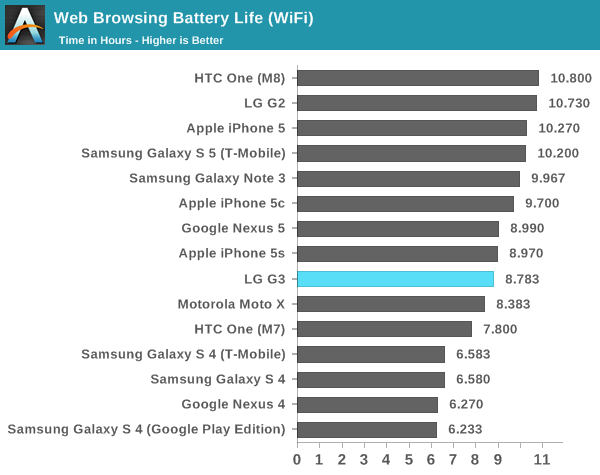
Here, the LG G3 has a major regression in battery life. While the LG G2 had around 11 hours of battery life on WiFi and was competitive with the Galaxy S5 and One (M8), the G3 is around the iPhone 5s in this test. There are a few reasons for this. If we compare battery capacity vs. display size, the LG begins at a disadvantage to HTC's One (M8). In order to equalize this gap, LG would need to fit the G3 with a 3150 mAh battery, something that would be difficult as a result of the loss in volumetric efficiency from the removable battery. The other reason is due to the lower panel efficiency, which is a direct result of the higher pixel density.
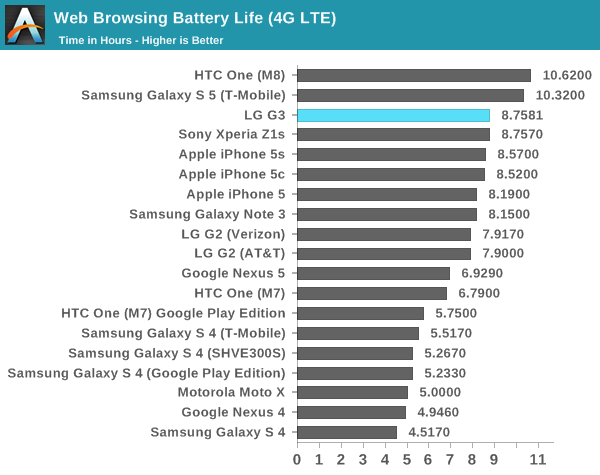
Surprisingly, in the LTE test we see a significant improvement over the LG G2, although it’s still behind the One (M8) and Galaxy S5 for the same reasons that I discussed in the WiFi test. These gains were likely made by improvements to RF and general process improvements such as envelope tracking and lower power process on the modem and other aspects of the SoC from S800 to S801.
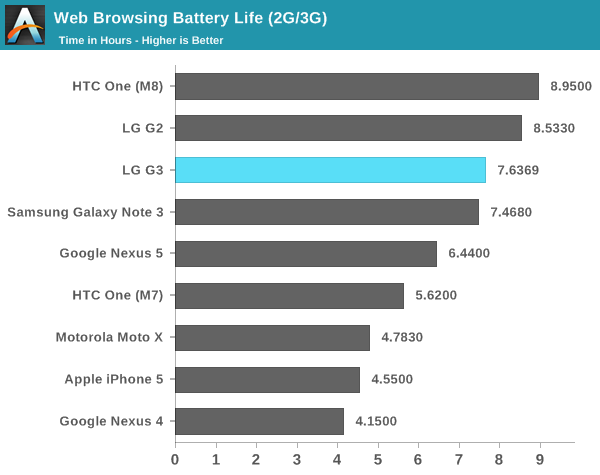
In WCDMA, there are very few surprises. As a result of bottlenecking on the network connection, battery life drops noticeably. The delta between the One (M8) and the G3 is relatively constant in this test as well, around 15-20% less in general.
Overall, the web test shows the power cost of the 1440p panel. However, in many situations the importance of display power efficiency can drop dramatically, especially if other components consume similar levels of power. To take a closer look at this, we turn to the compute-bound battery life tests. The first is GFXBench, which runs an endless loop of T-Rex on the display until the phone shuts down.
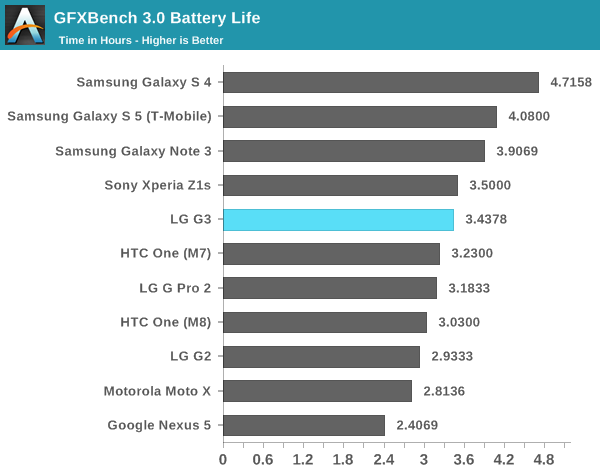
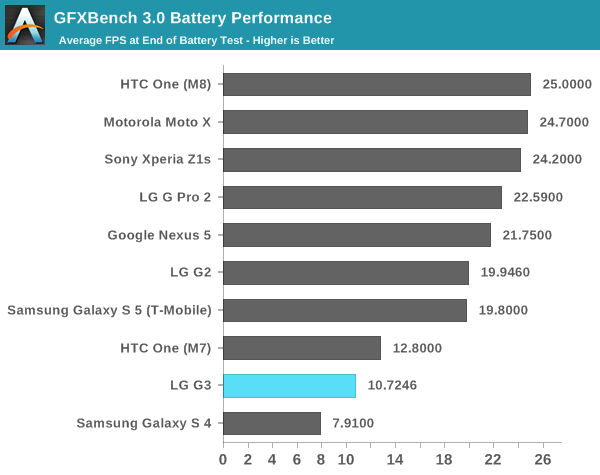
Here, we see that the LG G3 is between the One (M8) and Galaxy S5 in overall runtime. What’s surprising is that end of run FPS is below both the One (M8) and Galaxy S5, even when compensating for the difference in resolution by multiplying the score by 1.77. This actually places the LG G3 behind the G2.
However, looking at the overall picture, it’s very clear that LG is simply using a throttling mechanism that results in sinusoidal behavior. By averaging the last runs, the realistic end of run FPS is around 13.636. By scaling this to the 1080p-equivalent FPS, we see that the end of run FPS is actually around 24.1357. This means that there’s still a noticeable difference between the One (M8) and LG G3 in overall thermal dissipation capabilities, although not nearly as bad as the end of run FPS value might suggest.
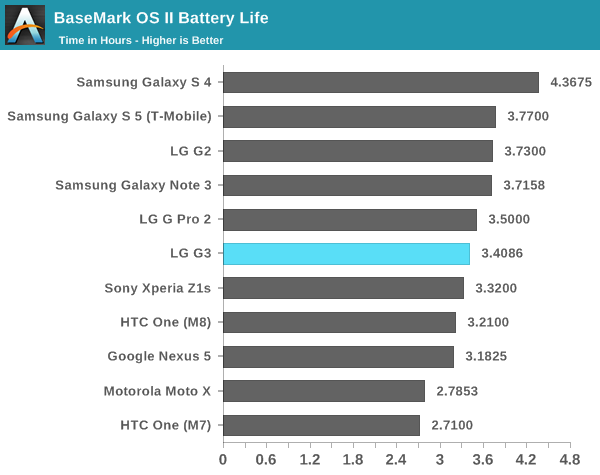
The next test is Basemark OS II, and we see that the battery life score sits between both the Galaxy S5 and One (M8), although it does worse than both of them in the battery score taking into account performance.
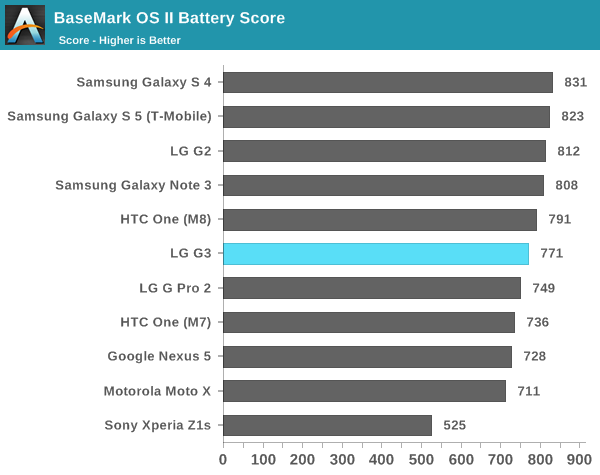
Overall, the LG G3 does acceptably well in battery life. However, after taking into account the dimming function it’s rather concerning how the G3 fails to keep up with the rest of the competition in this critical area. To really get a good idea what why this is though, we have to look at actual power numbers. This will allow us to truly quantify the power differences.
Charge Time
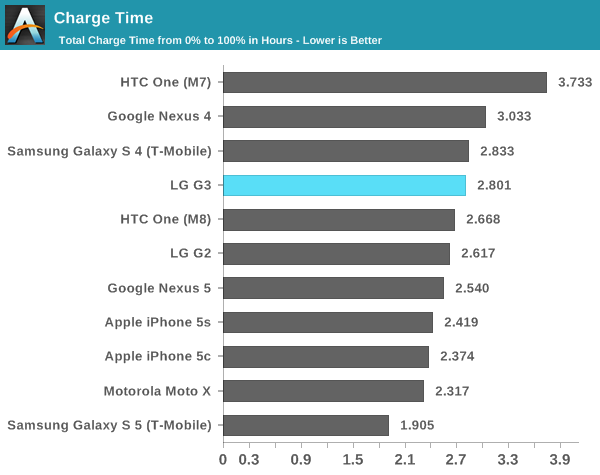
In this test, the LG G3 trails behind both the One (M8) and Galaxy S5 in charge time, although it's quite close to the One (M8). This is strange, especially because the LG G2 has the same battery size. However, this can be explained by the change to charging protocol, as it seems that the G3 doesn't support Qualcomm's Quick Charge technology. Instead, signalling is done over BC 1.2. As we'll see later in the article, this is due to the charger chip used.


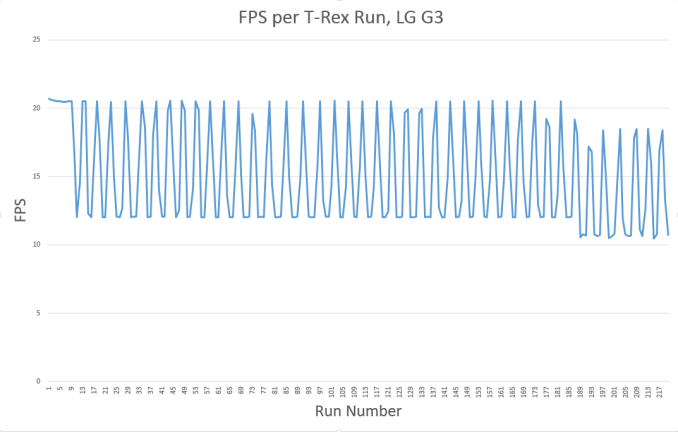








174 Comments
View All Comments
akdj - Sunday, July 13, 2014 - link
"...and sure in the heck are not paying $60 for a stupid case for that."That made me laugh. You're unwilling to throw down $60 on a case while 'considering' dropping/dumping or upgrading from one of today's 'Flagship' phones! Thanks though for the Sunday chuckle but WOW. Color me silly, but that's a helluva 'first world' challenge you've got going there! Anand posted an(other) excellent, well written review. Another flagship handset. Innovative display and yep...as so many others before you have mentioned... All at the expense of a bit of brightness (typically a 'non issue' as we use our phones most often indoors, and outdoors the measurements are still just 'fine' for usage & snapshots), wireless charging? Really, you're basing your purchase decision on an unproven, completely niche and rare...without common specification technology? I own a Note 3 & an iPhone 5s. The former, solely for my business. The latter, my personal phone. I love them both and honestly feel like we've hit that 'plateau' in performance. Almost a year in, I'm wondering if I'll even take advantage of the NEXT deal at AT&T. They're both still fast as hell, no way I'd notice any differences between those and today's offerings (iPhone TBD, obviously) from Android. While Sammy has improved its AMOLED technology in the S5 even more than the S4-->Note 3, I've used both and honestly, even as an almost three decade professional audio and video production company business owner and operator, the differences to me were hardly distinguishable. They've come a LONG way with AMOLED in comparison to the long time king of displays, the LCD, to the extent in many (possibly more than) measurements, it's taken over as the 'better' technology. Longevity? We're yet to see, but without Samsung innovating their technology, and listening to the detractors...or paying attention to reviews, numbers and measurements each generation, they'd have 'pulled out'. You've got a damn sweet phone NOW. There's not a single phone available today that's going to 'better' your M8 if you bought it knowing its strengths, and more importantly it's limitations. If you're looking for the all around 'best' camera, you made the wrong choice. If you take few photos or primarily shoot in low light situations ...you made the right choice. Hard to bitch about HTC's UI. It's excellent! While I'm one of the very few that actually 'like' T/W, you're probably best taking my GUI opinion with a grain of salt but other than your issue with contrast (valid complaint, IMHO as a 'visual geek'), I know I took a long time to get to the point, so ....
Tl/Dr, that's silly. Don't even THINK about replacing your M8 today. Unless you're A) still within the 'return period' and/or
B) not happy with the phone for some reason (why did you buy it? It's a bad ass hand set! Don't 'chase' specs, the genesis of technologies or 'absolutes' when it comes to a 'smartphone' --- in the end, you'll be underwhelmed, disappointed and you'll lose money EVERY time you do something so 'silly')
Ultimately today's smartphone market is awesome. With over two million apps between iOS and Android, Windows making their own moves (& certainly, while late to the game with the SP3, ousting of Balmer, and it's iOS MS Office suite 1.0 release...Win 365 subscription family package @ $10/month for five tabs and five computers and five users, EACH with a TB of their own storage accessible via OneNote from anywhere, anytime, GRAND SLAM! Go to Best Buy and save $40 for the year, about every other week they've got the bundle on sale...& it's completely 'cross platform' with an Android full release imminent, I'm an OSx user primarily but also own a pair of Windows machines. As well, being a Note 3 user, I'm very excited to see where MS is going...)
Yep. LG took a leap at this resolution. But they're one of very few display manufacturers. Most OEMs use Samsung, LG, or Sharp displays. Makes sense to me at least they'd be the ones aiming for the 'ultimate' resolution for human visual acuity. Is THIS the version to buy? If you're an original LG 'g1' owner, maybe switching out of an S3 contract, or not exactly crazy any longer with iOS and considering upgrading a 4s or iPhone 5 that you purchased almost two years ago, ABSOLUTELY! If you're an owner of a 2013 flagship, either iOS or Android, from those measurements (other than PPI/display technology and size preference), it's very obvious 2014 to this point had been 'iterative' with refinements to UIs (Samsung has definitely worked in TouchWiz instead of adding 'more' they've refined existing features, ala S-Pen/features and it's recognition when the pen is out ... Better overall ability to 'control' the OEM's pre-installed software (carrier bloat, different story but ubiquitous regardless of Android choice) -- point being they've succeeded with UI improvements and that's a BIG end user 'upgrade' IMHO. While the UI needs a refresh, a launcher of choice is a simple and cheap addition. The A7 hit Qualcomm like a ton of bricks. While indeed Apple is still a ways away from utilizing its full power due to RAM, the A8 instruction set, new memory management and the 7.1 'update' were HUGE. Obviously still keeping computational pace with significantly 'faster' clock speeds on half the cores with half the memory. As well - the dated IT graphics solution Apple used on the A7 will certainly be updated on the A8. Qualcomm will be ready with 64bit SOCs next year, or late this year. I guess my question would be 'why' HTC, Samsung, and LG aren't using the faster 805/420s today? Sorry to ramble but ultimately, I'm extremely excited to see this type of evolutionary improvement from one of today's largest display manufacturers. I'm glad to see the transition from '3D' to HiDPI from the 2011/12/13 CES shows to the '4K' and HiDPI displays shown off this past January in Vegas, and actually 'affordable' 1.0 releases @ Best Buy half way through '14. IMHO, display resolution rules the roost. With resolution, comes ALL the primary factors that make ANY resolution 'good' vs 'great". Attributes that come FAR before resolution updates, you're correct ...kind of. Brightness while important, especially in a cell phone is pretty important. Though as you can plainly see, it's still 'good' and easily visible outdoors. Contrast = Huge. Color and gamut/calibration as well as grey scale, gamma, display technology used, viewing angles, saturation and 'response time'. If you're gaming, you're looking for fast refresh rates, you'd hate my new Eizo. Soooo many factors that go into a good display and they're each (OEMs) beginning to 'get it'. Pre sale calibration. Options for, albeit limited post purchase calibration (TouchWiz and the display adaption option). Pushing barriers is good. My dream is to have 4k displays and a delivery system for the content in place by 2020. HiDPI displays are ubiquitous on computing displays. (Hard to explain my passion and 're' invigoration for using my computer, my laptop ...daily, since purchasing my first rMBP in 2012. We've now got seven, five for the business, two personal 15" 2013 rockets! PCIe TB storage that is faster than anything I've used in my life, a display that blows my mind EVERY time I turn it 'on' ...its I/O options, TB2 has become a GodSend for us, as have the new docks and the ability to literally turn it into a 'desktop' workstation (- the Xeon procs and enterprise RAM, you'd never know. It's truly THAT fast!)). I could go on and on but I guess I'm blown away by the 'reasons' some folks come up with to not replace their five month old bad ass pocket computer. Nor do I understand the backlash from our 'geek' community against LG for pushing the barriers AND using scientific reasoning to explain human visual acuity, how much density is 'truly' necessary to be indistinguishable from the sharpest photo, the finest print (especially for many traditional Asian writing/text/characters and alphabets)... Or and while I so hate the cliche itself; "Like looking through a window" ...IOW, his explanation was pertaining to the ability to 'see' in a display the 'same' visually your eye would see in a 'real world' scenario.
Again, all my opinion. Yours is different, I respect that. But I don't respect spec chasing, bullshit reasons to upgrade every three months to chase specs and bragging rights. That's dumb. It's not what you make, it's what you save. From your comment, I'm assuming your young (ya know what they say about assumption though). If I'm wrong, I'm sorry. If I'm correct, the difference in you saving that extra three to six hundred a year you're dropping on cell phones when you're 30, 40, 50...65 and ready to retire, is HUGE! Say you're 25. Without interest, that's $12-$24,000. With that cash each year and another $150/month stashed away starting at 20 instead of thirty in a fund that nets you an 8% average yearly increase (over 40 years) is 3.9 million @20 vs 2.2 million at 30 years old. At 40, you'll be lucky to hit a million. Figure out today what tomorrows 'Apple' stock will be and throw all that out the window. Buy all ya can and sell in a decade. You and the next six generations of your family won't have to work ;)
anishannayya - Tuesday, July 15, 2014 - link
No one has the time or energy to read your massive wall of text...tenaciousjesse - Tuesday, July 29, 2014 - link
Wow. You may have priceless knowledge. U DO ramble, but it's not just random idiotic rambling. Email me-jesse30135@Gmail.comsoldier4343 - Thursday, July 17, 2014 - link
Ignorant.TechShark - Monday, November 17, 2014 - link
I have a Sprint US G3 and the screen is super bright and colors seem very close to my iphone 6. I actually prefer the G3 display. I've heard that LG tweaked the display for the US version of the phone after some of the brightness and calibration criticisms about the Korean model such as was reviewed here. In fact on reviewer said he thought it might be a different panel altogether. Maybe Anandtech can look into this and see if recent US spec G3 models are in fact getting an improved display because mine is simple gorgeous and very bright.soldier4343 - Thursday, July 17, 2014 - link
Having the top of the line is all about bragging rights over actual benefit of a higher resolution.vr4africa - Friday, May 1, 2015 - link
I do not agree, with VR becoming big, I for one are big fan of VR, you need at least a 1440p screen. For proper VR you actually need a 4k screen. That is one of the reasons LG has pushed for the 2k screen. So if you were living under a rock the last 2 years and do not even know about VR, you should not make comments and judgement!hughlle - Friday, July 4, 2014 - link
And how do you arrive at that conclusion? It is stomped over by the G2 in the majority of the battery life tests.cylemmulo - Friday, July 4, 2014 - link
did you mix up the words G3 and G2?ASEdouard - Saturday, July 5, 2014 - link
I don't know. Brightness/viewing angles in a photo display is very important to me. I'd take that over the higher pixel count. I think I actually like the G2 better than the G3.